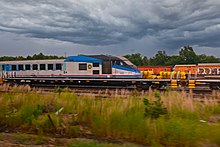Turboliner
The first batch, known as RTG, were built by the French firm ANF and entered service on multiple routes in the Midwestern United States in 1973.
Amtrak assumed control of almost all private sector intercity passenger rail service in the United States on May 1, 1971, with a mandate to reverse decades of decline.
[1] To operate these trains, Amtrak inherited a fleet of 300 locomotives (electric and diesel) and 1,190 passenger cars, most of which dated from the 1940s–1950s.
[5] The RTG (abbreviated from the French Rame à Turbine à Gaz, or gas turbine train)[8] model was an Americanized version of the French ANF T 2000 RTG Turbotrain (related to the prototype precursor to the very first TGV trainset, the TGV 001).
[10] Amtrak obtained a permanent waiver from the Federal Railroad Administration which exempted the RTGs from the buff strength requirement of 800,000 pounds-force (3,600 kN).
David P. Morgan, editor-in-chief of Trains magazine, was aboard for the initial run from Chicago to St Louis on September 28, 1973, and came away with mixed impressions.
[20] Advantages over conventional diesel equipment included increased availability, higher speed through curves, and decreased weight which caused less wear on the tracks.
[18] Amtrak contemplated ordering an additional 14 trainsets for the partially electrified Northeast Corridor between Boston and New York City.
Doing so would have required a significant rise in fares between the two cities, and the United States Department of Transportation blocked the proposal.
[23] Amtrak established a separate maintenance facility for all six trainsets in the Brighton Park neighborhood of Chicago, on the site of a former Gulf, Mobile & Ohio Railroad coach yard.
[24] This facility closed in 1981 after the withdrawal of the RTGs from service; according to Amtrak, the trainsets were too expensive to operate compared to conventional equipment.
[26] The two daily round-trips were branded Turboliner, replacing the individual names Abraham Lincoln and Prairie State.
The Federal Railroad Administration refused a request from Amtrak to raise the speed limit to 90 mph (140 km/h), citing inadequate signalling along the route.
The new trains had fallen out of favor by the end of 1974: food service was inadequate, and the five-car fixed consist could not handle demand.
Additional equipment allowed Amtrak to add a round-trip in late April; the arrival of a third trainset in May made Chicago–Detroit the "first all-turbine-powered route".
[34][35] They were based on the earlier RTG series, but had American-style Janney couplers throughout[9] and a different design of power car cab.
[38] These were the final gas turbine trainsets purchased by Amtrak; conventional diesel locomotive-hauled trains proved cheaper to operate.
Although the RTGs continued to operate under a waiver from the regulation, the RTLs were built to meet the Federal Railroad Administration's buff strength requirement of 800,000 pounds (362,873.9 kg).
[6] The RTL Turboliners were capable of third rail operation, allowing them to enter Grand Central Terminal and, later, Pennsylvania Station in New York City.
[41] As it had with the earlier RTGs in the Midwest, Amtrak set up a separate maintenance facility in Rensselaer, New York.
[42] As built, the RTLs carried 2,560 US gallons (9,700 L; 2,130 imp gal) of fuel, permitting an operational range of 950 miles (1,530 km).
[41] In 1995, Amtrak and the State of New York collaborated to rebuild a single RTL trainset at a cost of $2 million.
In test runs on the Empire and Northeast Corridors, it reached a top speed of 125 mph (201 km/h), all the while consuming less fuel than previously.
[57] New York, which was paying $150,000 per year to store the unused trains, auctioned off its four surplus Turboliners in 2012 for $420,000, including spare parts; scrapping began in 2013.

